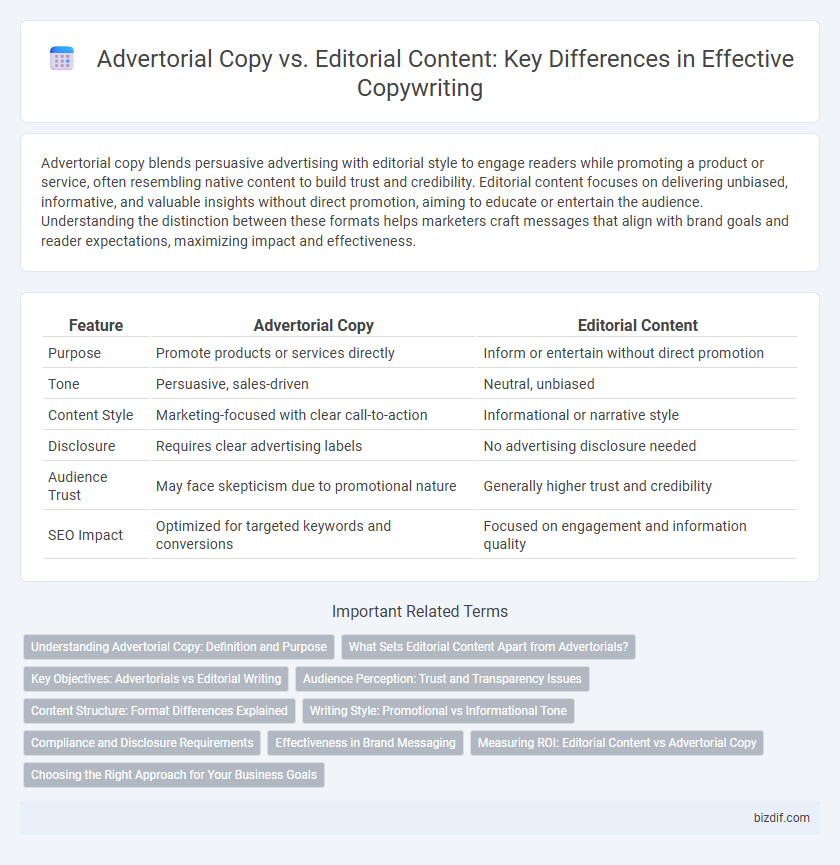Advertorial copy blends persuasive advertising with editorial style to engage readers while promoting a product or service, often resembling native content to build trust and credibility. Editorial content focuses on delivering unbiased, informative, and valuable insights without direct promotion, aiming to educate or entertain the audience. Understanding the distinction between these formats helps marketers craft messages that align with brand goals and reader expectations, maximizing impact and effectiveness.
Table of Comparison
| Feature | Advertorial Copy | Editorial Content |
|---|---|---|
| Purpose | Promote products or services directly | Inform or entertain without direct promotion |
| Tone | Persuasive, sales-driven | Neutral, unbiased |
| Content Style | Marketing-focused with clear call-to-action | Informational or narrative style |
| Disclosure | Requires clear advertising labels | No advertising disclosure needed |
| Audience Trust | May face skepticism due to promotional nature | Generally higher trust and credibility |
| SEO Impact | Optimized for targeted keywords and conversions | Focused on engagement and information quality |
Understanding Advertorial Copy: Definition and Purpose
Advertorial copy is a hybrid form of content combining advertising and editorial styles designed to promote products or services while providing valuable information. It aims to engage readers with persuasive storytelling that subtly integrates brand messages, creating trust and driving conversions without overt sales pressure. This content type blends informative elements with promotional intent to influence purchasing decisions effectively.
What Sets Editorial Content Apart from Advertorials?
Editorial content distinguishes itself from advertorial copy through its primary focus on providing unbiased, informative, and value-driven material that engages readers without overtly promoting a brand. It is typically created by independent journalists or editorial teams prioritizing credibility and trust, enhancing audience loyalty. Unlike advertorials, which blend advertising and editorial styles to subtly market products, editorial content upholds journalistic integrity by maintaining objectivity and editorial standards.
Key Objectives: Advertorials vs Editorial Writing
Advertorial copy aims to promote products or services by blending persuasive sales techniques with informative content to drive conversions and brand awareness. Editorial content focuses on providing unbiased, value-driven information to engage readers and build trust without direct sales intent. Key objectives for advertorials include generating leads and increasing sales, while editorial writing prioritizes educating the audience and fostering long-term reader loyalty.
Audience Perception: Trust and Transparency Issues
Advertorial copy often faces skepticism from audiences due to its promotional nature disguised as editorial content, raising concerns about trust and transparency. Editorial content is generally perceived as more credible because it prioritizes unbiased information and journalistic integrity. Clear labeling and honest communication in advertorials are essential to maintain audience trust and avoid damaging brand reputation.
Content Structure: Format Differences Explained
Advertorial copy adopts a persuasive structure designed to seamlessly blend advertising with editorial style, often featuring clear calls-to-action and targeted messaging to drive conversions. Editorial content emphasizes an informative, objective format with a narrative flow aimed at educating or entertaining readers without overt sales pitches. The key structural difference lies in advertorials integrating promotional elements within storytelling, while editorial pieces maintain impartiality and prioritize reader engagement through well-organized, fact-based segments.
Writing Style: Promotional vs Informational Tone
Advertorial copy employs a promotional tone designed to persuade readers by highlighting product benefits and encouraging action, using direct and engaging language. Editorial content maintains an informational tone, prioritizing unbiased insights and in-depth analysis to educate and inform the audience without overt sales pressure. Balancing these writing styles involves tailoring the message to either drive conversions through compelling calls-to-action or build trust through factual storytelling.
Compliance and Disclosure Requirements
Advertorial copy must clearly disclose its promotional nature to comply with FTC guidelines, ensuring transparency and maintaining consumer trust. Editorial content, by contrast, is grounded in unbiased reporting and is not subject to the same disclosure requirements, but must avoid hidden advertising to preserve integrity. Adhering to compliance standards prevents legal risks and enhances brand credibility across digital and print media.
Effectiveness in Brand Messaging
Advertorial copy blends persuasive advertising with informative content, driving higher engagement by subtly promoting brand messages within valuable narratives. Editorial content establishes credibility and trust through unbiased, informative articles that enhance brand authority without overt selling. Combining both approaches optimizes brand messaging effectiveness by balancing promotion with authenticity, ultimately increasing consumer connection and conversion rates.
Measuring ROI: Editorial Content vs Advertorial Copy
Measuring ROI for advertorial copy often reveals higher direct conversion rates due to its persuasive, sales-driven nature targeting specific customer actions. Editorial content tends to yield long-term brand awareness and trust, making ROI measurement more complex but valuable for sustained engagement. Combining analytics tools like engagement metrics and sales tracking provides a clearer comparison between immediate advertorial effectiveness and the enduring impact of editorial storytelling.
Choosing the Right Approach for Your Business Goals
Advertorial copy blends persuasive advertising techniques with informative content to directly drive conversions and brand awareness, making it ideal for businesses aiming for immediate impact. Editorial content offers unbiased, value-driven storytelling that builds long-term trust and authority, aligning with goals focused on relationship-building and brand reputation. Selecting between advertorial and editorial approaches depends on your business objectives, target audience preferences, and desired engagement outcomes.
Advertorial Copy vs Editorial Content Infographic

 bizdif.com
bizdif.com